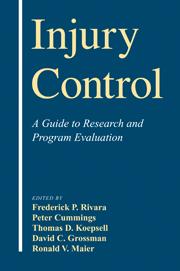Book contents
- Frontmatter
- Contents
- List of Contributors
- 1 An Overview of Injury Research
- 2 Classifying and Counting Injury
- 3 Measurement of Injury Severity and Co-morbidity
- 4 Data Linkages and Using Administrative and Secondary Databases
- 5 Rates, Rate Denominators, and Rate Comparisons
- 6 Data Collection Methods
- 7 Selecting a Study Design for Injury Research
- 8 Qualitative Methods in Injury Research
- 9 Randomized Trials
- 10 Cohort Studies in Injury Research
- 11 Case–Control Studies in Injury Research
- 12 Ecologic Studies
- 13 Case Series and Trauma Registries
- 14 Systematic Reviews of Injury Studies
- 15 Evaluating an Injury Intervention or Program
- 16 The Development of Clinical Decision Rules for Injury Care
- 17 Trauma Performance Improvement
- 18 Measuring Disability and Quality of Life Postinjury
- 19 Economic Evaluation of Injury Control
- 20 Ethical Issues
- Index
8 - Qualitative Methods in Injury Research
Published online by Cambridge University Press: 16 October 2009
- Frontmatter
- Contents
- List of Contributors
- 1 An Overview of Injury Research
- 2 Classifying and Counting Injury
- 3 Measurement of Injury Severity and Co-morbidity
- 4 Data Linkages and Using Administrative and Secondary Databases
- 5 Rates, Rate Denominators, and Rate Comparisons
- 6 Data Collection Methods
- 7 Selecting a Study Design for Injury Research
- 8 Qualitative Methods in Injury Research
- 9 Randomized Trials
- 10 Cohort Studies in Injury Research
- 11 Case–Control Studies in Injury Research
- 12 Ecologic Studies
- 13 Case Series and Trauma Registries
- 14 Systematic Reviews of Injury Studies
- 15 Evaluating an Injury Intervention or Program
- 16 The Development of Clinical Decision Rules for Injury Care
- 17 Trauma Performance Improvement
- 18 Measuring Disability and Quality of Life Postinjury
- 19 Economic Evaluation of Injury Control
- 20 Ethical Issues
- Index
Summary
Overview
Much of the content of this book is devoted to research methods that are anchored in the collection, analysis, and interpretation of numerical data. This is often referred to as quantitative research. All disciplines involved in the field of injury control predominantly make use of quantitative techniques in the conduct of research. Another domain of research methodology relies largely on the use of nonquantitative data and is broadly referred to as qualitative research.
This chapter will concentrate on the potential roles of qualitative research in the conduct of injury research investigations. An overview of methodologic issues in qualitative research will also be presented with reference to three major qualitative research traditions: ethnography (and ethnographic interviewing), participant observation, and focus groups. Sampling, data collection, and measures to ensure reliability and validity of qualitative studies are discussed.
Definition of Qualitative Research
Qualitative research is a broad term designating a family of diverse research traditions that share some common features. One key shared feature is the use of non-numerical data. Instead of collecting and analyzing numbers, most qualitative methods focus on the collection and analysis of narrative data. The family of qualitative traditions includes ethnography, focus group methodology, grounded theory, case studies, participant observation, phenomenology, and others.
Qualitative research methods are, in some respects, fundamentally different from traditional quantitative methods used in epidemiology, biostatistics, and health services research. The qualitative and quantitative paradigms are complementary approaches associated with different strengths and weaknesses. The challenge for the researcher is to recognize method most suitable for the type of question being addressed (Berkwits and Aronowitz, 1995).
Keywords
- Type
- Chapter
- Information
- Injury ControlA Guide to Research and Program Evaluation, pp. 104 - 115Publisher: Cambridge University PressPrint publication year: 2000

